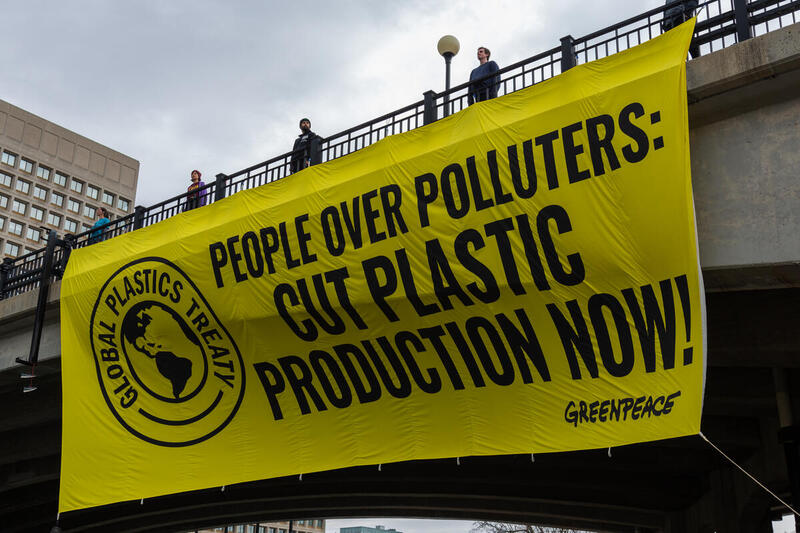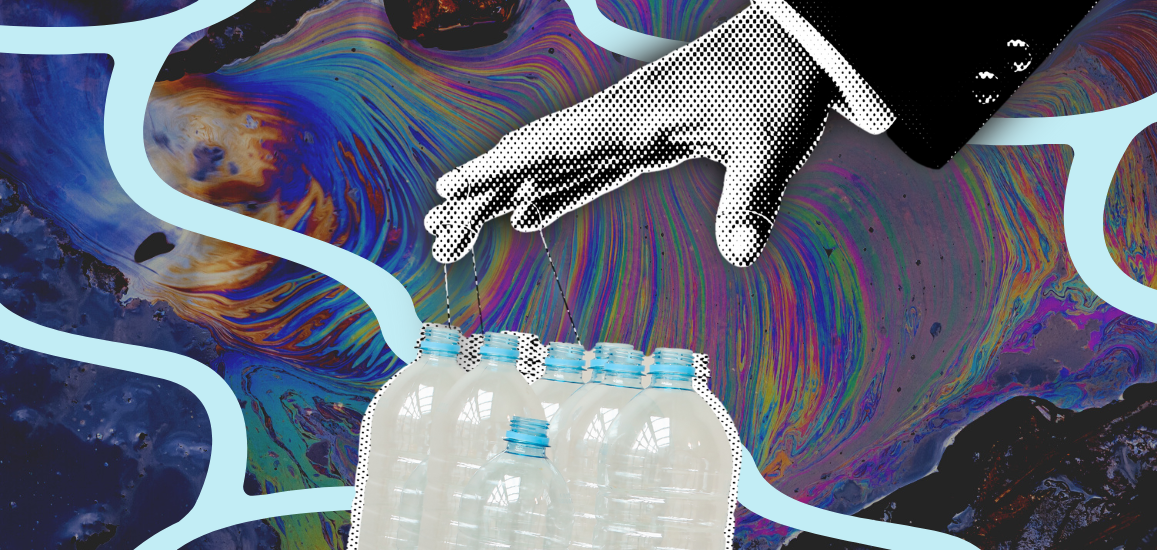What new research has Greenpeace uncovered about Canadian plastic waste exports?
Research commissioned by Greenpeace Canada shows where Canada has diverted its plastic waste exports since China announced its ban on the import of various types of plastic waste. Malaysia was found to be the biggest new export destination for Canada [1] and other high-income countries, importing nearly half a million tonnes between January and July 2018. [2] A recent on the ground investigation conducted by Greenpeace Malaysia connected Canadian branded trash to an unregulated Malaysian facility and helped shine a light on the burden of high-income countries’ massive onslaught of plastic waste to Southeast Asian countries.
When did China decide to ban the import of lower-grade plastics and other recycling?
A year ago, beginning on January 1st, 2018, China officially prohibited the import of 24 categories of recyclable materials, including eight types of plastic, but actually began taking action to phase out those materials in 2017. China had become the world’s largest importer of recyclables.
How much recycled plastic was Canada exporting to China before the ban?
In 2015, Canada exported 100,618 tonnes of plastic waste to China (including Hong Kong). In 2017 the amount exported to China halved to just 48,143 mt between Q1 and Q3. Monthly exports of Canadian plastic waste began to fall drastically in March 2017 until December 2017 when they leveled off at the current rate of about 600 mt per month. [3]
How has Canada’s export of plastic recycling changed as a result of the China ban?
Since the announcement of China’s ban on various types of plastic waste imports, Canada has been experiencing a small, persistent overall decline in the amount of plastic waste it is exporting. In the six month period following implementation of the ban, Canadian exports of plastic waste to countries other than China and the USA more than doubled, from about 10,300 tonnes to 24,000 tonnes. [4]
Malaysia and Thailand’s Canadian plastic waste imports show the most obvious correlation between increased imports and China’s ban, with a significant increase in the overall amount of Canadian plastic waste imported. Over the Q1 to Q3 period in 2018, Canadian export data shows that Malaysia’s imports of Canadian plastic waste almost doubled compared to the same period in 2017 (5,140 tonnes to 9,954 tonnes), and Thailand’s imports tripled over the same period (1,156 tonnes to 4,744 tonnes). These two countries exhibit the same pattern, with imports to each country spiking after the ban was announced, followed by an overall reduction in imports between May and June of 2018. [5] Malaysian government data shows a higher imported tonnage of plastic waste from Canada to that reported by Statistics Canada after the China ban at over 16,000 tonnes in the first half of 2018. [6]
Taiwan, South Korea, Turkey, Pakistan, and Indonesia have been slowly but steadily increasing overall plastic waste imports from Canada following the original announcement of the ban, but each remain small importers. Of these countries, Taiwan stands out as the biggest, yet even Taiwan remains below 500 tonnes per month. [7]
What did Greenpeace’s investigation in Malaysia find?
Based on information received from the Kuala Langat Environmental Protection Association in Malaysia, Greenpeace ran a 2-week field investigation in mid-October visiting ‘active sites’ where imported plastic waste being illegally dumped or burned had been reported. Forty-five sites with plastic waste were identified, containing trash from at least 19 countries including the USA, UK, Spain, Austria, Germany, Sweden, Ireland, Portugal, France, Belgium, Switzerland, Australia, New Zealand, Saudi Arabia, Cyprus, Argentina, Romania, the Philippines, and Canada. Among these locations were active illegal burning sites and dumpsites. [8]
The investigation suggests that unregulated processing of imported plastic wastes in Malaysia continued despite an announcement from the Malaysian government of an import ban. Many likely unlicensed facilities are still operating and most of them are located near residential areas. These facilities show indications of illegal operations, or at best poorly regulated, as they do not have proper physical infrastructure to process the plastic waste and therefore are posing environmental and health hazards to surrounding communities. [9]
Trucks loaded with plastic waste coming and going from unregulated [10] facilities were spotted, plastic waste could be seen in abundance and open burning of plastic waste took place in some of the sites we investigated. Samples of plastic waste from 19 countries were collected and recorded across all sites, taking photos and videos as evidence. Personal interviews were also conducted with a number of local residents and activists and information provided was cross matched with available official information to determine whether sites were legal or illegal. [11]
Greenpeace found branded plastic trash from Canada in Jenjarom, Kuala Langat, an unregulated facility where community members reported illegal plastic waste dumping and burning activities to be having negative impacts.
In the report detailing the investigation findings entitled “The Recycling Myth: Malaysia and the Broken Global Recycling System”, Greenpeace shines a light on the failings of the global recycling system, reinforcing that much of what people in various countries in the Global North think is being diverted for recycling is actually ending up illegally dumped, burned or landfilled in countries in the Global South.
What Canadian branded plastic was found at an unregulated Malaysian site?
The following visible company brands with discernable Canadian origin were found on plastics discovered in Jenjarom (Kuala Langat):
Sobeys Eastern Embers, Shaw Resources/The Shaw Group Ltd.
Ben’s, Ben’s bakery Croutons, Interprovincial Cooperative Limited (IPCO)
Scotsburn, Saputo Inc. Canawick, Groupe Savoie Inc. Windsor, K+S Windsor Salt Ltd. Armstrong, Armstrong Milling Co. Ltd.
Plastic from Nova Scotia
What are the impacts of the rise of plastic imports on Malaysia and other countries?
During the investigation, Greenpeace was shocked by the extent of the environmental pollution and health conditions likely caused by open-air burning and dumping of imported plastic waste. Much of the imported waste is also being dumped in landfills. The imported waste is often not processed correctly but dumped or burned in unregulated ways. Criminal actors in Southeast Asia have abused the inability of legal operators and the failure of authorities to cope with the increased imports. Greenpeace’s investigation discovered that Malaysia does not have an adequate system in place to deal with the surge in plastic waste imports. [12]
The burning of plastics releases a number of toxic chemicals gases and liquids dangerous to humans, such as carbon monoxide, chloroform and persistent environmental pollutants like dioxin. Dioxin is released to the environment by incomplete burning processes or uncontrolled waste incineration of plastics. [13] Pollution was also discovered in water bodies, including some adjacent to prawn farms. [14]
How have Southeast Asian governments reacted to the increase in imports?
Southeast Asian importers such as Vietnam, Thailand, Malaysia, and Indonesia have not been able to handle the increase in plastic waste imports. They have restricted the imports of plastic scraps after facing a spike in import violations. [15] Southeast Asian countries are scrambling to find solutions to tackle illegal activities, tighten policies and strengthen law enforcement. [16]
What is Canada’s international obligation on this issue?
The Basel Convention on the Control of Transboundary Movements of Hazardous Wastes and Their Disposal is a multilateral agreement negotiated under the United Nations Environment Program (UNEP) in 1988 to establish standards for transboundary movement of hazardous wastes and other wastes. Under this multilateral agreement, Canada is obligated to recognize the risks posed by wastes to human health and take necessary measures to ensure the management of hazardous wastes and other wastes, including their transboundary movement and disposal, does not endanger human health or pollute the environment at the place of disposal. States where the wastes are generated, such as Canada, must ensure that the transport and disposal of wastes in an importing country are conducted in an environmentally friendly manner. The transboundary movement of wastes should therefore be permitted only when the operation of waste disposal does not endanger human health and the environment.
Countries exporting plastic waste to Malaysia and Malaysia itself have failed to fulfil their international legal responsibility under the Basel convention as illegal dumping and open burning of imported plastic waste in Klang and Kuala Langat continue to threaten the health of local citizens, including children, and pollute the air, water and soil around illegal dumpsites.[17]
What is Greenpeace recommending
Greenpeace is calling on the Canadian government to first and foremost investigate the recycling export industry on possible fraud and illegal practices and take immediate action against recycling companies that knowingly export plastic waste to unlicensed operators in low- or middle-income countries. The government must amend its current Zero Plastic Waste Strategy to ensure focus more on reduction to begin to address the growing plastic waste problem that creates the conditions for Canada to offload our problem on other countries without due diligence, resulting in using them as dumping grounds. Greenpeace is urging the Trudeau government to act swiftly to ban problematic and unnecessary single-use plastics, incentivize a shift to more sustainable product delivery systems and hold corporations accountable for the full lifecycle of their products, including any resulting plastic pollution.
Notes:
[1] Statistics Canada, Canadian International Merchandise Trade Database. Accessed December 2018
[2] A. Ananthalakshmi and E. Chow, “Swamped with plastic waste: Malaysia struggles as global scrap piles up,” October 25th, 2018, 2018. [Online]. Available: https://www.reuters.com/ article/us-malaysia-waste/swamped-with-plastic-waste-malaysia-struggles-as-global-scrap- piles-up-idUSKCN1MZ0P4?il=0. [Accessed: 08-Nov-2018].
[3] Statistics Canada, Canadian International Merchandise Trade Database. Accessed December 2018
[4] Statistics Canada, Canadian International Merchandise Trade Database. Accessed December 2018
[5] Statistics Canada, Canadian International Merchandise Trade Database. Accessed December 2018
[6] Department_of_National_Solid_Waste_Management, “Imports of Waste, Pairings and Scrap of HS3915 Plastics,” 2018.
[7] Statistics Canada, Canadian International Merchandise Trade Database. Accessed December 2018
[8] Greenpeace Malaysia. The Recycling Myth: Malaysia and the broken global recycling system. Nov. 2018.
[9] Greenpeace Malaysia. The Recycling Myth: Malaysia and the broken global recycling system. Nov. 2018.
[10] Note ‘unregulated’ is used instead of ‘illegal’ because it could not be confirmed without a doubt that some facilities did not have a permit.
[11] Greenpeace Malaysia. The Recycling Myth: Malaysia and the broken global recycling system. Nov. 2018.
[12] Greenpeace Malaysia. The Recycling Myth: Malaysia and the broken global recycling system. Nov. 2018.
[13] Jabatan_Pengurusan_Sisa_Pepejal_Negara, “Laman Web Rasmi Jabatan Pengurusan Sisa Pepejal Negara,” Sept 07 2016, 2016. [Online]. Available: http://jpspn.kpkt.gov.my/index. php/pages/view/145. [Accessed: 25-Oct-2018].
[14] Greenpeace Malaysia. The Recycling Myth: Malaysia and the broken global recycling system. Nov. 2018.
[15] C. Staub, “Import restrictions ripple across Southeast Asia – Plastics Recycling Update,” June 6th 2018, 2018. [Online]. Available: https://resource-recycling.com/plastics/2018/06/06/ import-restrictions-ripple-across-southeast-asia/. [Accessed: 24-Oct-2018].
[16] Greenpeace Malaysia. The Recycling Myth: Malaysia and the broken global recycling system. Nov. 2018.
[17] Greenpeace Malaysia. The Recycling Myth: Malaysia and the broken global recycling system. Nov. 2018.


